India’s Deep-Sea Mineral Exploration in the Indian Ocean

- 05 Oct 2025
In News:
India has achieved a major milestone in deep-sea exploration by signing a new 15-year contract with the International Seabed Authority (ISA) for the exclusive exploration of Polymetallic Sulphides (PMS) in a 10,000 sq km area of the Carlsberg Ridge in the Indian Ocean.
With this agreement, India has become the first country in the world to hold two PMS exploration contracts, commanding the largest area allocated globally for such exploration. This advancement marks a blend of scientific progress, strategic foresight, and economic opportunity within India’s broader Blue Economy vision.
Polymetallic Sulphides and Their Significance
Polymetallic Sulphides are mineral-rich deposits found on the ocean floor, primarily near hydrothermal vents along mid-ocean ridges. Formed through interactions between seawater and magma beneath the Earth’s crust, they contain valuable metals such as copper, zinc, lead, gold, silver, and trace rare elements.
For India, these minerals are crucial for high-technology industries, renewable energy systems, and green technologies. Given the country’s limited terrestrial reserves, deep-sea exploration ensures resource security, supports the energy transition, and reduces import dependence on critical minerals.
India’s Deep Ocean Initiatives
India’s engagement with the ISA dates back over three decades. It was among the earliest countries to receive an area for polymetallic nodule exploration, earning the status of a “Pioneer Investor.” The first PMS exploration contract was signed in 2016 for the Central and Southwest Indian Ridges, and the latest agreement in 2025 extends exploration to the Carlsberg Ridge, located near 2°N latitude — significantly closer to India than the earlier sites.
The National Centre for Polar and Ocean Research (NCPOR) in Goa, under the Ministry of Earth Sciences (MoES), will begin exploration operations in 2026, employing geophysical, hydrographic, and near-seabed surveys.
These efforts are supported by the Deep Ocean Mission, launched by the Government of India to develop seabed mining technology, autonomous underwater vehicles (AUVs), and the Matsya submersible under the Samudrayaan Mission. This ecosystem strengthens India’s capacity for scientific research, environmental assessment, and mineral resource utilisation.
The Carlsberg Ridge: A Strategic and Scientific Hub
The Carlsberg Ridge is a part of the mid-ocean ridge system formed by the divergence of the Indian and Somali plates about 40 million years ago. With a spreading rate of 2.4–3.3 cm per year, it features hydrothermal vent systems ideal for PMS deposits. Its proximity to India enhances logistical feasibility and strategic relevance. The region’s exploration will expand understanding of deep-sea geology, marine ecosystems, and plate tectonics, while supporting India’s long-term maritime interests.
Exploration Challenges and Governance
PMS exploration is among the most technically demanding deep-sea missions, occurring at depths of 2,000–5,000 metres in rugged, volcanic terrains. It demands multidisciplinary collaboration across marine geology, geophysics, biology, and ocean engineering, supported by dynamic-positioning vessels, AUVs, and ROVs.
The ISA, functioning under the United Nations Convention on the Law of the Sea (UNCLOS), regulates seabed exploration beyond national jurisdictions. Applications must meet rigorous standards of environmental protection, financial capability, and scientific planning before approval.
Future Prospects
Beyond PMS, India has applied for exploration rights over cobalt-rich ferromanganese crusts on the Afanasy-Nikitin Seamount in the Central Indian Ocean, aligning with its Blue Economy and resource security goals. Hosting the 8th ISA Annual Contractors’ Meeting in Goa underscores India’s growing leadership in global seabed research governance.
Conclusion
India’s twin PMS contracts with the ISA mark a historic milestone in ocean science, resource diplomacy, and sustainable technology development. By combining strategic exploration, indigenous innovation, and environmental stewardship, India is positioning itself at the forefront of responsible deep-sea resource management — a critical pillar of its vision for a self-reliant and resilient Blue Economy.
Rising Extreme Rainfall in the Himalayas
- 20 Sep 2025
In News:
The 2025 monsoon season has witnessed intense and destructive rainfall across North India, particularly in the Himalayan states of Uttarakhand, Himachal Pradesh, and Jammu & Kashmir. Cloudbursts, landslides, and flash floods have resulted in widespread devastation, exposing the growing vulnerability of India’s mountain ecosystems and urban regions. The intensification of monsoon rainfall can be traced to the complex interplay of global climate change, regional topography, and anthropogenic factors such as urbanisation and deforestation.
Scientific Basis of Intensified Rainfall
Dry regions like northwestern India lie at the confluence of tropical and extratropical systems. Moist monsoon currents from the Bay of Bengal and Arabian Sea increasingly collide with western disturbances, producing strong atmospheric instability and torrential rainfall. This interaction has become more frequent as climate change alters the behaviour of mid-latitude westerlies.
Global warming weakens and destabilises the jet stream, allowing westerly troughs to extend southward and interact with the monsoon more often. A warmer atmosphere holds more moisture, intensifying the hydrological cycle and leading to heavier downpours. These processes have made events like the recent Udhampur (630 mm in 24 hours) and Leh (59 mm in two days) rainfall episodes more common, even in regions historically considered semi-arid.
Why the Himalayas Are More Vulnerable
The Himalayas sit at the convergence of moist tropical monsoon winds and mid-latitude westerlies, creating ideal conditions for orographic uplift and deep convection that trigger extreme precipitation and cloudbursts. When moisture-laden air is forced up steep slopes, it cools rapidly and condenses into intense, localised storms.
Climate change compounds this natural vulnerability. Rapid Arctic warming is weakening the jet stream, causing slower and more meandering weather systems that linger over regions, leading to prolonged heavy rainfall. Similar dynamics have been linked to the Pakistan floods (2010), Germany (2021), and West Asia (2024) events.
In mountainous terrain, rainfall that would be manageable in coastal plains becomes catastrophic — flash floods and landslides occur as water cascades downhill, carrying debris, loose soil, and boulders. Over the last month, such incidents have been recorded in Mandi, Kullu, Dharali, Tharali, and Jammu, destroying homes and cutting off roads.
Challenges in Prediction and Preparedness
Despite technological advances, forecasting cloudbursts remains challenging. Current systems employ Doppler Weather Radars (DWRs), satellites (INSAT-3D/3DR, GPM, Himawari), rain gauges, and high-resolution numerical weather prediction (NWP) models. However, coverage in Himalayan terrain is sparse, satellite resolution is coarse, and models require ultra-fine grid scales (<1 km) with precise initial conditions.
Improved dense observation networks, enhanced process-based models, and integration of AI/ML techniques for real-time data assimilation are critical for reliable nowcasting.
Urban and Developmental Pressures
Rapid urbanisation, deforestation, and construction on unstable slopes have magnified the flood risks in both mountain towns and plains cities. Urban drainage systems, designed for rainfall of only 10–20 mm/hour, are ill-equipped for cloudbursts exceeding 100 mm/hour. Concretised surfaces increase runoff, while encroachments block natural drainage, turning heavy rain into urban deluges.
Mitigation demands a multi-pronged approach—redesigning stormwater systems, enforcing land-use regulations, restoring natural water channels, and incorporating climate risk assessments in infrastructure planning.
Conclusion
The increasing frequency of extreme rainfall and cloudbursts in India’s Himalayan and urban regions reflects the intersection of climate dynamics, fragile topography, and unsustainable development. Strengthening early warning systems, integrating scientific forecasting with local planning, and promoting climate-resilient infrastructure are essential to mitigate future disasters. The Himalayan crisis underscores a broader reality—climate change is no longer a distant threat but an unfolding challenge demanding immediate, coordinated action.
Migration and Globalisation

- 31 Aug 2025
Context:
Migration has historically been central to human survival, cultural enrichment, and economic development. Nobel laureate Amartya Sen, in a recent interaction with students in Kolkata (August 2025), underlined that migration is not merely a by-product of globalisation but an essential driver of it. He argued that without the movement of people, exchange of ideas, and diversity, “almost nothing would happen” in society. His observations highlight the need to place migration at the core of discussions on inclusive development and global integration.
Migration and Globalisation: A Two-Way Link
Migration represents both a cause and consequence of globalisation. The growing interconnectedness of economies, labour markets, and cultures compels people to move in search of livelihood, education, and security. Conversely, migration sustains the very processes of globalisation by ensuring labour mobility, knowledge transfer, and cultural exchange.
Remittances from international migrants significantly support local economies in poorer regions, while in ageing industrial societies, migrants fill labour shortages and keep welfare systems functional. Similarly, internal migration within developing countries responds to shifts in industrial location and the expansion of tourism, service, and construction sectors.
Economic and Social Contributions of Migrants
Migration plays a critical role in sustaining households and reshaping communities:
- Economic Support: Remittances are often the backbone of rural economies, enabling investments in agriculture, housing, and small enterprises.
- Skill Transfer: Return migrants bring exposure, technology, and non-farm opportunities, provided there is institutional support.
- Cultural Exchange: Migrants enrich host societies by introducing new languages, cuisines, music, and traditions, fostering cosmopolitan growth.
- Empowerment: For many youth and women, migration becomes a pathway to independence, autonomy, and expanded life choices.
Sen himself cited historical examples—such as Arabic translations of Brahmagupta’s mathematical works—that demonstrate how migration and cultural contact drive intellectual advancement.
Key Challenges
Despite its benefits, migration remains highly contested. Restrictive immigration policies in developed nations often strengthen illegal smuggling networks and leave migrants vulnerable to exploitation. Within India, internal migrants frequently face exclusion from basic urban services such as housing, education, and healthcare.
Undocumented and unskilled migrants are particularly prone to labour exploitation, earning low wages under insecure conditions. Women migrants confront additional gender disparities, ranging from wage inequality to social stigma, although they can emerge as strong agents of change where given resources and support.
Policy Imperatives
Migration must be recognised not as a threat but as an enabler of development. The policy framework should:
- Protect migrant rights and improve workplace safety.
- Facilitate the productive use of remittances through training, financial literacy, and infrastructure.
- Ensure equitable access to resources for women migrants.
- Address structural constraints such as rural distress, which force people into migration as a survival strategy.
India has already witnessed tensions, including attacks on migrant workers from West Bengal in other states, highlighting the urgency of a protective and inclusive approach.
Conclusion
Migration is inseparable from globalisation and has historically propelled human progress. It strengthens economies, sustains welfare systems, and enriches cultures. Yet, the absence of supportive policies leaves migrants vulnerable to exclusion and exploitation. As Amartya Sen emphasised, diversity is the foundation of Indian society and the movement of people is the essence of globalisation. Recognising migrants as partners in development rather than problems to be managed is essential for building an inclusive, equitable, and resilient global future.
Why India needs stable urban forests
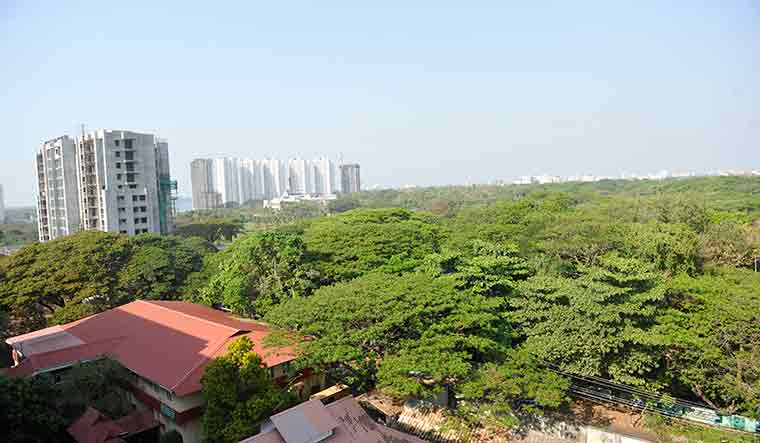
- 24 May 2025
In News:
Urban forests are increasingly emerging as critical ecological buffers amidst India’s rapidly expanding cities. The recent controversy over the Kancha Gachibowli forest in Hyderabad—where 400 acres of urban forest land were earmarked for industrial development—has reignited debates on sustainable urbanisation and environmental governance. The Supreme Court’s intervention to halt further deforestation underscores the urgent need to prioritise ecological assets in urban planning.
Importance of Urban Forests
Urban forests such as Kancha Gachibowli (Hyderabad), Aarey (Mumbai), Turahalli (Bengaluru), Neela Hauz and the Ridge (Delhi), and Dol Ka Baadh (Jaipur) play a vital role in maintaining ecological balance within metropolitan environments. Their multifaceted contributions include:
- Air Pollution Mitigation: Urban forests absorb pollutants such as PM2.5 and PM10, which are major contributors to urban air pollution from vehicular emissions and construction activity.
- A 2006 study by the USDA Forest Service found that one hectare of forest can remove approximately one ton of air pollutants annually.
- In November 2024, the Central Pollution Control Board (CPCB) recorded a hazardous AQI of 494 in Delhi, highlighting the urgent need for natural air purifiers.
- Climate Regulation: These forests help reduce the urban heat island effect, control stormwater runoff, and mitigate urban flooding and erosion.
- Carbon Sequestration: Trees in urban forests trap atmospheric carbon, contributing to climate change mitigation efforts.
- Biodiversity Preservation: They serve as urban habitats for endangered birds, insects, and other fauna, supporting biodiversity within city limits.
- Socio-Cultural Benefits: Urban forests offer green spaces for recreation, promote mental well-being, and enhance the overall livability of urban areas.
Threats and Challenges
Despite their importance, urban forests in India face increasing threats due to:
- Unregulated Urban Expansion: Urban planning often disregards ecological sustainability, prioritising infrastructure and industrial development over green spaces.
- Lack of Legal Clarity: State governments sometimes contest the status of forest lands, as seen in Telangana’s claim over Kancha Gachibowli, undermining forest protections.
- Real Estate Pressures: Encroachments and land-use changes for commercial gain are frequent, with environmental concerns often sidelined.
Judicial Interventions and Constitutional Provisions
Indian courts have played a pivotal role in safeguarding urban forests:
- T.N. GodavarmanThirumulpad Case (1996): Expanded the definition of "forest" to include areas recorded as forest in government records, irrespective of ownership or classification.
- Delhi High Court (2015): Directed the protection and notification of the Delhi Ridge forest.
- Supreme Court Stay on Aarey Tree Felling (2020): Responded to civil society petitions to preserve Mumbai’s Aarey forest.
- Rajasthan High Court Suo Motu Action (2024): Intervened against deforestation in biodiversity-rich Baran district.
Constitutional Backing:
- Article 21: Guarantees the Right to Life, interpreted by courts to include the right to a clean and healthy environment.
- Article 48A: Directs the State to protect and improve the environment.
- Article 51A(g): Makes it a fundamental duty of citizens to protect the natural environment.
Policy Interventions: Nagar Van Yojana
In response to growing ecological concerns, the Ministry of Environment, Forest and Climate Change (MoEF&CC) launched the Nagar Van Yojana in 2020 with the goal of developing 1,000 urban forests by 2027.
- As per the India State of Forest Report 2023, the initiative has already led to an increase of 1,445.81 sq km in tree and forest cover in urban areas.
- The scheme aligns with other policy frameworks such as the National Forest Policy (1988) and the National Mission for Green India (2014), which promote afforestation and ecological restoration.
Way Forward
To ensure sustainable urbanisation, India must:
- Integrate ecological planning into urban masterplans, with mandatory forest inventories and zoning protections.
- Strengthen legal protections for notified and unnotified forests within urban areas.
- Foster community participation and civil society engagement in urban environmental stewardship.
- Promote green infrastructure through Smart Cities and AMRUT missions.
Conclusion
Urban forests are not peripheral luxuries but ecological necessities. Their conservation is essential for ensuring environmental resilience, public health, and urban quality of life. As India continues its urbanisation journey, a harmonious balance between development and ecological preservation is indispensable.
Delhi’s unprecedented Pre-Monsoon Rainfall
- 14 May 2025
In News:
On May 2, 2024, Delhi witnessed one of its most intense pre-monsoon weather events in over a century, recording the second-highest single-day rainfall for May since 1901, surpassed only by 119.3 mm in 2021. This extreme event, though meteorologically significant, also underscores critical vulnerabilities in urban disaster preparedness and climate resilience.
Meteorological Dynamics behind the event
This rare weather event was driven by a complex interplay of meteorological phenomena. Delhi became the focal point for two moisture-laden wind systems: easterlies from the Bay of Bengal and southerlies from the Arabian Sea. Their collision over the National Capital Region created a low-level convergence zone, which forced moisture-rich air upward, initiating intense convective activity.
Compounding this situation was the presence of troughs—elongated low-pressure systems—that enhanced instability and facilitated vertical atmospheric lifting. As the moist air ascended, it cooled rapidly, forming towering cumulonimbus clouds reaching altitudes of over 13 km. These clouds, commonly associated with thunderstorms and intense rainfall, released torrential downpours over the city.
Additionally, the region was under the influence of a Western Disturbance, coupled with upper-air cyclonic circulations over Rajasthan and Punjab. These systems altered wind patterns, induced powerful vertical lifts, and further fed moisture into the storm system through an active monsoon trough extending from Madhya Pradesh to Kerala.
Timing and Transitional Weather
The event occurred during May, a transitional month for northern India as it shifts from spring to the monsoon phase. This seasonal flux often leads to volatile weather, but the scale and intensity observed this year were unusual and alarming. Factors such as strong westerly surface winds (up to 54 kmph) and cool descending winds from the Himalayas further enhanced convection, creating a perfect storm scenario.
Impacts on Urban Infrastructure
The heavy rainfall overwhelmed Delhi’s urban infrastructure. Several parts of the city faced severe waterlogging, power outages, flight disruptions, and, tragically, five deaths due to weather-related accidents. The lack of adequate stormwater drainage systems, combined with high urban density and poor land-use planning, exacerbated the crisis.
Broader Implications for Policy and Planning
This event serves as a wake-up call for urban disaster management and climate adaptation. With climate variability increasing the frequency and intensity of extreme weather events, Indian cities—especially megacities like Delhi—must invest in climate-resilient infrastructure.
Policymakers must:
- Strengthen early warning systems and inter-agency coordination.
- Enhance urban planning with a focus on green infrastructure and permeable surfaces.
- Improve data integration across meteorological and civic bodies for real-time response.
- Mainstream climate risk assessments in city development plans.
Conclusion
Delhi’s record-breaking rainfall is not just a weather anomaly but a symptom of deeper systemic vulnerabilities. It emphasizes the urgent need for holistic, science-backed urban resilience strategies to safeguard lives, infrastructure, and ecological balance in a rapidly urbanizing and warming world.
Myanmar-Thailand Earthquake 2025
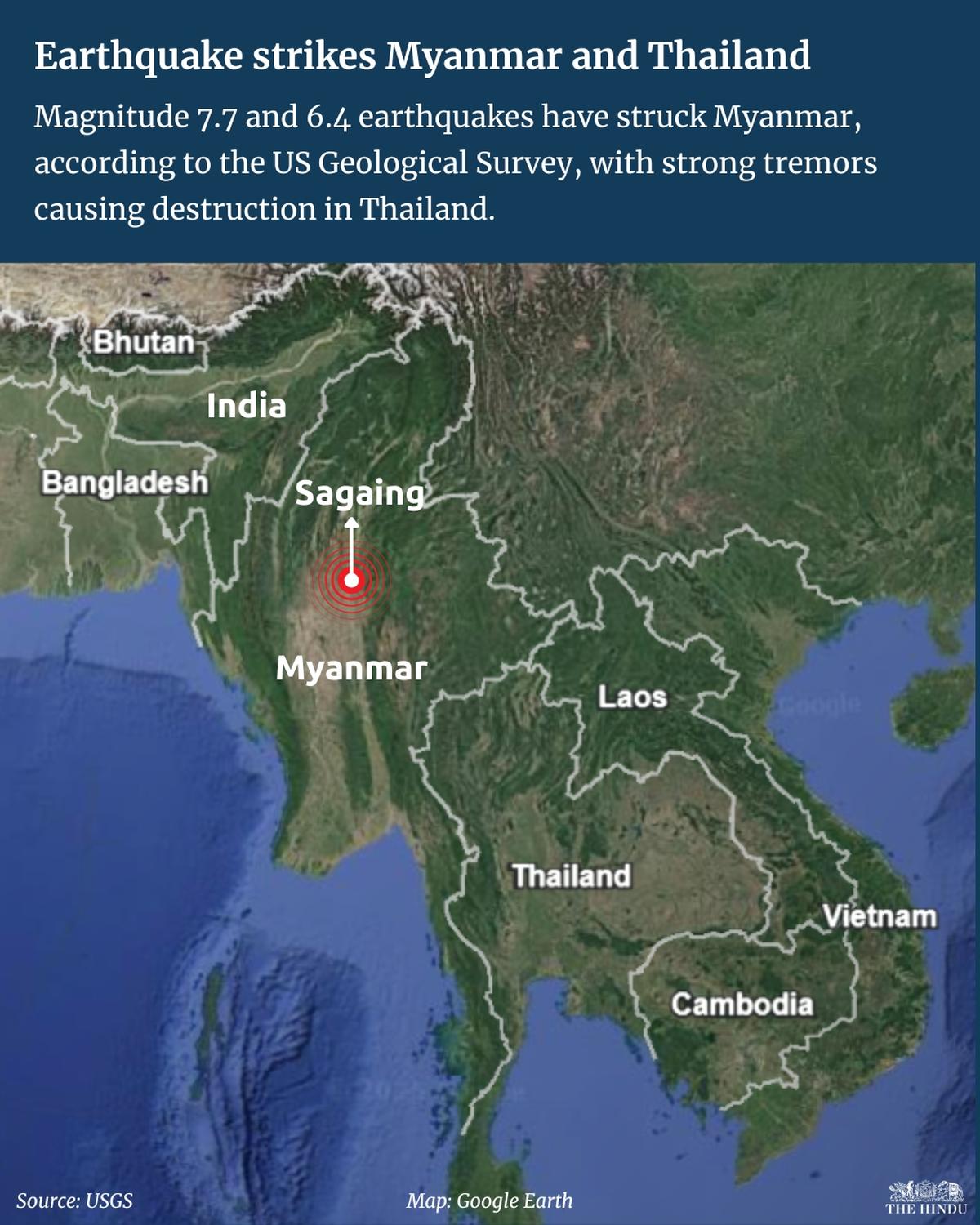
- 30 Mar 2025
In News:
Recently, a devastating 7.7 magnitude earthquake struck central Myanmar near Mandalay, resulting in catastrophic destruction across Myanmar and Thailand. The tremor, the strongest in the region in 75 years and globally the most powerful in two years, occurred at a shallow depth of 10 km, amplifying its destructive impact.
Human and Structural Impact
In Myanmar, at least 144 people were killed and 730 injured, while in Thailand, particularly Bangkok, eight deaths were confirmed, including three from a 33-storey building collapse. The death toll is expected to rise as search and rescue operations continue. Infrastructure damage was widespread—residential buildings, pagodas, a dam, and a 90-year-old bridge in Myanmar collapsed. In Bangkok, high-rises swayed dangerously, rapid transit systems shut down, and panic gripped the city. Over 90 people were reported missing in Bangkok’s construction site collapse.
The quake severely impacted regions already suffering from ongoing humanitarian crises, particularly Myanmar, where a civil war has displaced over 3 million people, and 20 million are in need of assistance, according to the UN. Emergency services were hindered by damaged roads and downed power lines.
Geological Context and Causes
The earthquake was caused by strike-slip faulting along the Sagaing Fault, a major tectonic boundary between the Indian and Eurasian plates. This north-south fault is highly seismically active and has been responsible for several past quakes, including those in 1839 (M 8.3), 1912 (M 7.9), and 2016 (M 6.9).
Shallow-focus earthquakes like this one, occurring at just 10 km depth, tend to cause significant surface damage due to minimal energy dissipation before the seismic waves reach the surface. Additionally, seismic waves radiate along the entire fault line, affecting regions far beyond the epicenter, including China’s Yunnan and Sichuan provinces, where structural damage and injuries were also reported.
Preparedness and Vulnerabilities
Myanmar's infrastructure is ill-prepared for high-magnitude earthquakes, especially in the Mandalay region where modern seismic-resistant construction is limited. The USGS estimated potential fatalities between 10,000 and 100,000, and economic losses up to 70% of Myanmar’s GDP, underscoring the country’s vulnerability. The affected area lies in the central region of the country, less accustomed to high-magnitude tremors than the traditionally more seismically active western regions.
International and Regional Response
Myanmar declared a state of emergency in six regions, including Naypyidaw and Mandalay. Thailand’s city hall declared Bangkok a disaster zone to mobilize emergency responses. Indian Prime Minister Narendra Modi offered immediate support, stating that Indian authorities and the Ministry of External Affairs are in touch with both governments. The disaster also holds diplomatic relevance, with Bangkok set to host the BIMSTEC Summit, highlighting the importance of regional disaster cooperation.
Conclusion
The 2025 Myanmar-Thailand earthquake exposes the urgent need for seismic resilience, urban preparedness, and regional disaster response cooperation in South and Southeast Asia. With climate change and tectonic vulnerabilities intersecting, India and neighboring nations must integrate robust disaster management frameworks into developmental planning and regional diplomacy.
Tracking Migration in India
- 25 Mar 2025
In News:
The Covid-19 pandemic significantly altered migration patterns in India, with a massive reverse migration from urban areas to rural regions. The first lockdown saw 44.13 million people migrating, followed by 26.3 million during the second lockdown. These migrants, mostly low-wage workers, faced hardships like wage theft, food insecurity, and a lack of healthcare. Many, reliant on remittances, were economically strained.
Rebound of Rural-to-Urban Migration
Five years post-pandemic, migration trends have largely reverted to pre-Covid patterns. The rural economy struggled to accommodate returning migrants, offering limited job opportunities and low wages, leading many to return to urban centers. Rural distress and urban aspirations, supported by schemes like the Smart Cities Mission, continue to drive migration. Projections suggest that by 2026, 40% of India’s population will reside in urban areas. Additionally, climate change is intensifying migration, especially in agrarian states like Odisha, where disrupted agriculture forces people to migrate.
Shifts in International Migration
International migration also experienced changes post-Covid. While Indian emigrants faced challenges like job losses and poor living conditions abroad, remittances remained resilient, reaching $83.15 billion in 2020. Migration patterns shifted, with increasing numbers moving to Europe, particularly skilled professionals benefiting from the EU Blue Card program. Migration to Africa has also risen, driven by growth in sectors like IT and healthcare. The pandemic also fueled a rise in student migration, with the number of student emigrants from Kerala nearly doubling from 1.29 lakh in 2018 to 2.5 lakh in 2023.
Governance Challenges in Migration
Despite changes in migration patterns, several governance challenges persist. The lack of up-to-date migration data, compounded by delays in the 2021 Census and outdated figures from the Periodic Labour Force Survey (PLFS), hampers effective policy-making. The Ministry of External Affairs' data underrepresents seasonal and temporary migrants, while illegal migration remains largely untracked.
Moreover, social security schemes remain inadequately implemented. The e-Shram portal, designed for unorganised workers, faces limited uptake due to digital exclusion and awareness gaps. Similarly, the One Nation One Ration Card (ONORC) scheme only covers part of the migrant population. Legal protections for migrant workers, like those under the Inter-State Migrant Workmen Act, 1979, remain weak, and the implementation of new Labour Codes introduced in 2020 is still incomplete.
Vulnerabilities and Gaps in Support
Certain vulnerable groups, such as migrant women and children, are often neglected in migration policies. Women face risks of trafficking and exploitation, while children suffer from disrupted education and inadequate healthcare. Climate-induced migration, resulting from floods and droughts, is also under-addressed in disaster management and climate adaptation policies, leaving communities unsupported during distress-induced mobility.
Recommendations for Strengthening Migration Governance
To address these challenges, India must strengthen migration governance:
- Robust Migration Data Systems: Expand Kerala’s migration surveys to other states for better national data systems.
- National Migration Policy: Expedite the NITI Aayog’s draft policy to ensure inter-ministerial coordination and gender-sensitive provisions.
- International Migration Frameworks: Enhance labour mobility agreements with emerging destinations like Europe and Africa, along with skill-building initiatives.
- Improved Social Security Access: Implement the Code on Social Security, 2020, and ensure portability of benefits across states.
- One-Stop Migrant Facilitation Centers: Establish urban centers to assist migrants with registration, legal aid, and grievance redressal.
- Address Vulnerable Groups: Develop policies protecting migrant women and children, ensuring education and healthcare access.
- Climate-Induced Migration: Integrate climate migration in national policies for adequate community support.
Conclusion
Migration in India has largely returned to urban centers, but governance remains a challenge. Strengthening migration data, enhancing social security systems, and improving coordination at all levels of government will ensure that migration serves as a tool for development and the welfare of millions of migrants across India.
La Niña 2024–25
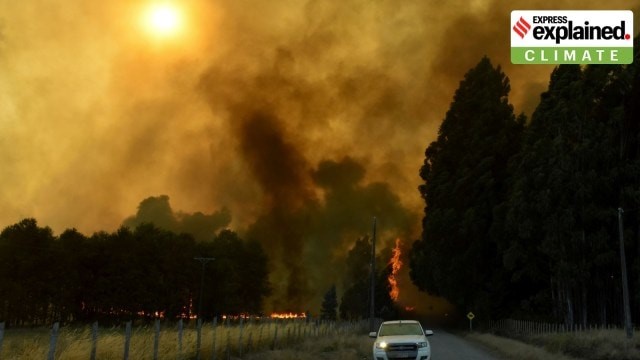
- 15 Feb 2025
In News:
Despite the expected cooling influence of La Niña, January 2025 became the hottest January on record, with global average surface air temperatures 1.75°C above pre-industrial levels (1850–1900), according to the Copernicus Climate Change Service (C3S). This marked the 18th out of the last 19 months that global temperatures exceeded the 1.5°C threshold. The inability of La Niña to curb this warming trend underscores the intensifying impact of anthropogenic climate change.
Understanding La Niña and the ENSO Cycle
La Niña, meaning "The Little Girl" in Spanish, is the cool phase of the El Niño Southern Oscillation (ENSO)—a recurring climate phenomenon involving variations in oceanic and atmospheric conditions in the central and eastern tropical Pacific Ocean.
- Phases of ENSO:
- El Niño (warm phase): Warmer ocean temperatures in the eastern Pacific, weakening trade winds and reducing rainfall in the western Pacific.
- La Niña (cool phase): Colder sea surface temperatures in the eastern Pacific, strengthening trade winds and enhancing rainfall in the western Pacific.
- Neutral phase: Sea surface temperatures are near average with no dominant anomalies.
- Mechanism: During La Niña, strengthened trade winds push warm surface waters westward, causing cold waters to upwell in the eastern Pacific. This typically results in global cooling.
- ENSO Cycle: These phases occur every 2 to 7 years and influence weather patterns globally. The ENSO cycle leads to sea surface temperature variations between ±1°C to ±3°C from the long-term average.
The 2024–25 La Niña: A Weakened Climate Driver
- Emergence: The current La Niña phase began in December 2024, later than anticipated. Forecasts had expected it around September 2024, giving it insufficient time to strengthen before its typical peak in the Northern Hemisphere winter.
- Intensity: It is projected to be a mild La Niña, reducing its capacity to significantly influence global temperatures.
- Past Events: The most recent La Niña cycle lasted from 2020 to 2023, followed by a strong El Niño through mid-2023.
- Delayed Cooling Effect: The weaker-than-usual La Niña failed to produce the anticipated cooling, surprising scientists. As Julien Nicolas from Copernicus observed, the expected “temporary brake” on global temperatures did not materialize.
Why January 2025 Remained Hot Despite La Niña
- Global Ocean Warming: Oceans have retained higher-than-usual warmth due to long-term climate change, diluting La Niña’s cooling influence.
- Weak La Niña Onset: A late and weak phase meant less disruption to the prevailing warming trend. According to NOAA, La Niña events need more time and intensity to impact temperatures effectively.
- Persistent GHG Emissions: The concentration of greenhouse gases reached record highs in 2024, adding to the Earth's heat burden. Typically, La Niña-induced rains spur vegetation growth and carbon absorption, but weaker rains in this cycle limited that effect.
- Reduced Aerosols: Declines in atmospheric aerosols—due to cleaner air policies—lessened their usual cooling impact. Aerosols scatter solar radiation and influence cloud dynamics, contributing to temperature moderation.
Global and Regional Climatic Impacts of La Niña
Despite its weak intensity, La Niña still shaped regional weather in varied ways:
Asia
- India: Higher monsoon rainfall (July–September) is expected. This boosts rice production but may reduce pulse output in the Indo-Gangetic Plain.
- Southeast Asia: Nations like Indonesia, Malaysia, and the Philippines face increased rainfall—raising flood risks but aiding rice and palm oil yields.
South America
- Southern Brazil, Uruguay, northern Argentina, and southern Bolivia face drought due to reduced rainfall, affecting soybean and maize crops.
- Northern Brazil, Colombia, Venezuela, and parts of Ecuador and Peru receive excess rain, risking floods.
Africa
- East Africa: Experiences dry conditions in December–January, hampering harvests in February–March.
- Southern Africa: Receives above-average rainfall, benefitting crops like maize, wheat, sorghum, and soybeans.
Oceania
- Australia: Faces heavy rain and possible flooding in its northern and eastern regions.
North America
- Southern US: Experiences dry conditions.
- Northern US, Canada, and Alaska face wetter, stormier weather.
Significance for India
- Agriculture: Enhanced monsoon rains improve farm productivity, especially rice.
- Water Resources: Better reservoir levels alleviate water stress.
- Energy: Increases hydropower potential.
- Heat Mitigation: Reduces severity of heatwaves compared to El Niño years.
Monitoring & Prediction
- Oceanic Niño Index (ONI): Tracks 3-month average SST anomalies. Values below –0.5°C indicate La Niña.
- Nino-3.4 Index: Confirms ENSO thresholds. Anomalies of ±0.5°C signal event onset; ±1.5°C indicates strong events.
- Tools Used: Satellite data, trade wind strength, and ocean buoys support forecasts. La Niña can be predicted up to two years in advance if preceded by a strong El Niño.
Conclusion:
The 2024–25 La Niña's inability to cool global temperatures highlights a worrisome trend—the diminishing moderating influence of natural climate phenomena. With greenhouse gas emissions continuing to rise and natural cooling cycles weakening, urgent global action is needed to reduce emissions and mitigate climate change impacts.
Arctic Sea Ice Changes May Alter India's Monsoon Patterns
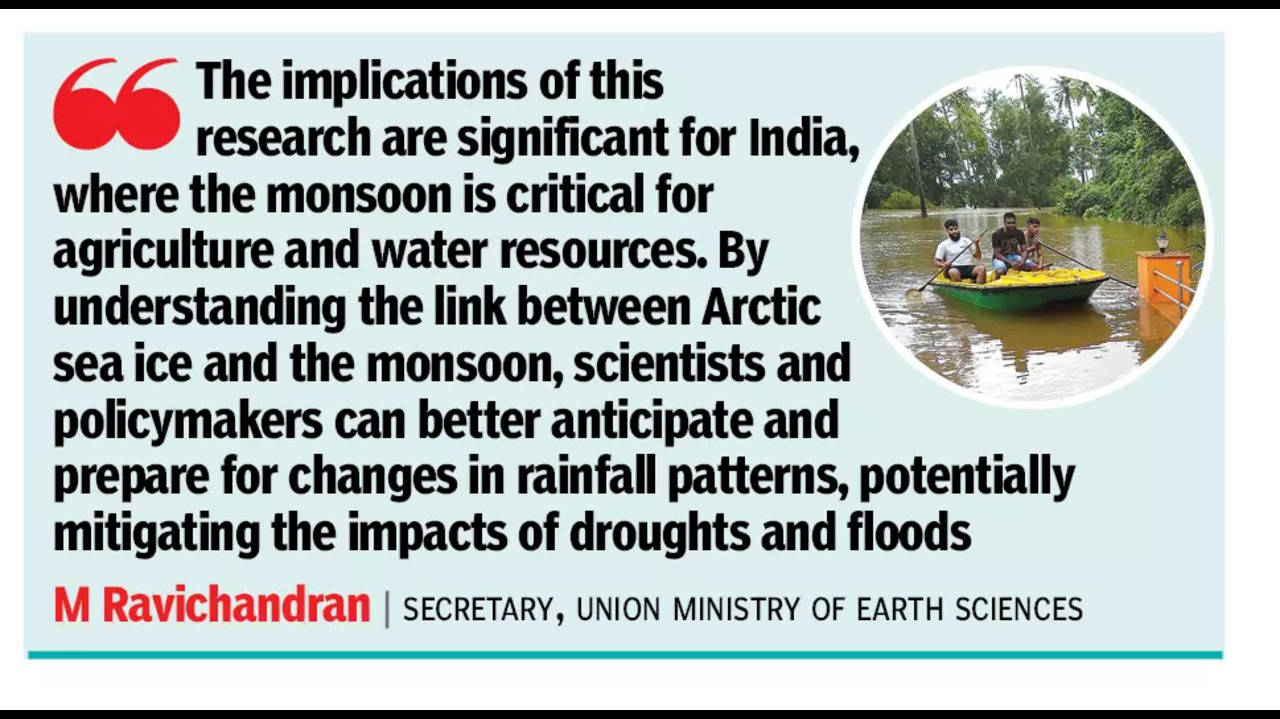
- 09 Sep 2024
In News:
A study by researchers from India’s National Centre for Polar and Ocean Research (NCPOR) has found that seasonal variations in Arctic Sea ice are impacting the Indian monsoon.
What is the Indian Summer Monsoon Rainfall?
The Indian Summer Monsoon Rainfall (ISMR), occurring from July to September, is one of the most significant monsoon systems globally. During the summer, the Central Asian and Indian landmasses heat up more quickly than the surrounding oceans. This temperature difference creates a low-pressure zone at the Tropic of Cancer known as the intertropical convergence zone (ITCZ). Trade winds from the southeast are then deflected toward the Indian subcontinent due to the Coriolis effect and the low pressure they encounter after crossing the equator. As these winds pass over the Arabian Sea, they pick up moisture and bring rain to India. The southwest monsoon divides into two branches over the Indian landmass. The Arabian Sea branch delivers rain to the west coast, while the Bay of Bengal branch brings rain to the eastern and northeastern parts of India. These branches converge over Punjab and Himachal Pradesh, with the Arabian Sea branch moving inward and the Bay of Bengal branch following the Himalayas.
Complexity of the Indian Summer Monsoon Rainfall
Recent climate models have revealed that the ISMR is influenced by the surface temperatures of the Indian, Atlantic, and Pacific Oceans. Additionally, the circum-global teleconnection (CGT), a large-scale atmospheric wave at mid-latitudes, also plays a significant role in affecting the monsoon.
Influence of Arctic Sea Ice on the Indian Monsoon
The study indicates that reduced sea ice in the central Arctic results in decreased rainfall in western and peninsular India, but increased rainfall in central and northern India. Conversely, lower sea ice levels in the upper latitudes, especially in the Barents-Kara Sea region, delay the onset of the monsoon and make it more unpredictable.
Other Atmospheric Systems Influencing the Pattern
When sea ice levels in the central Arctic rise, the heat transferred from the ocean to the atmosphere triggers cyclonic circulation at lower latitudes, such as the North Atlantic. This process enhances Rossby waves—fast-moving air currents created by Earth's rotation and temperature differences—which move from west to east. These waves cause high pressure over northwest India and low pressure over the Mediterranean region, strengthening the Asian jet stream over the Caspian Sea and shifting the subtropical easterly jet northward. This shift leads to increased rainfall in western and peninsular India. On the other hand, decreased sea ice in the Barents-Kara Sea generates an anticyclonic circulation (clear skies) over northwest Europe. This disturbance affects the upper atmosphere over subtropical Asia and India, resulting in increased rainfall in northeastern India while leaving central and northwest regions drier.
Role of Climate Change
Climate change accelerates the reduction of Arctic sea ice, which intensifies the variability and unpredictability of the ISMR. Lower Arctic sea ice contributes to more frequent and severe droughts in some areas, while causing excessive rainfall and flooding in others. The study underscores the urgent need for expanded research on climate dynamics and more accurate monsoon forecasts to address these changing patterns.
La Niña Delays and Its Impact on India’s Weather
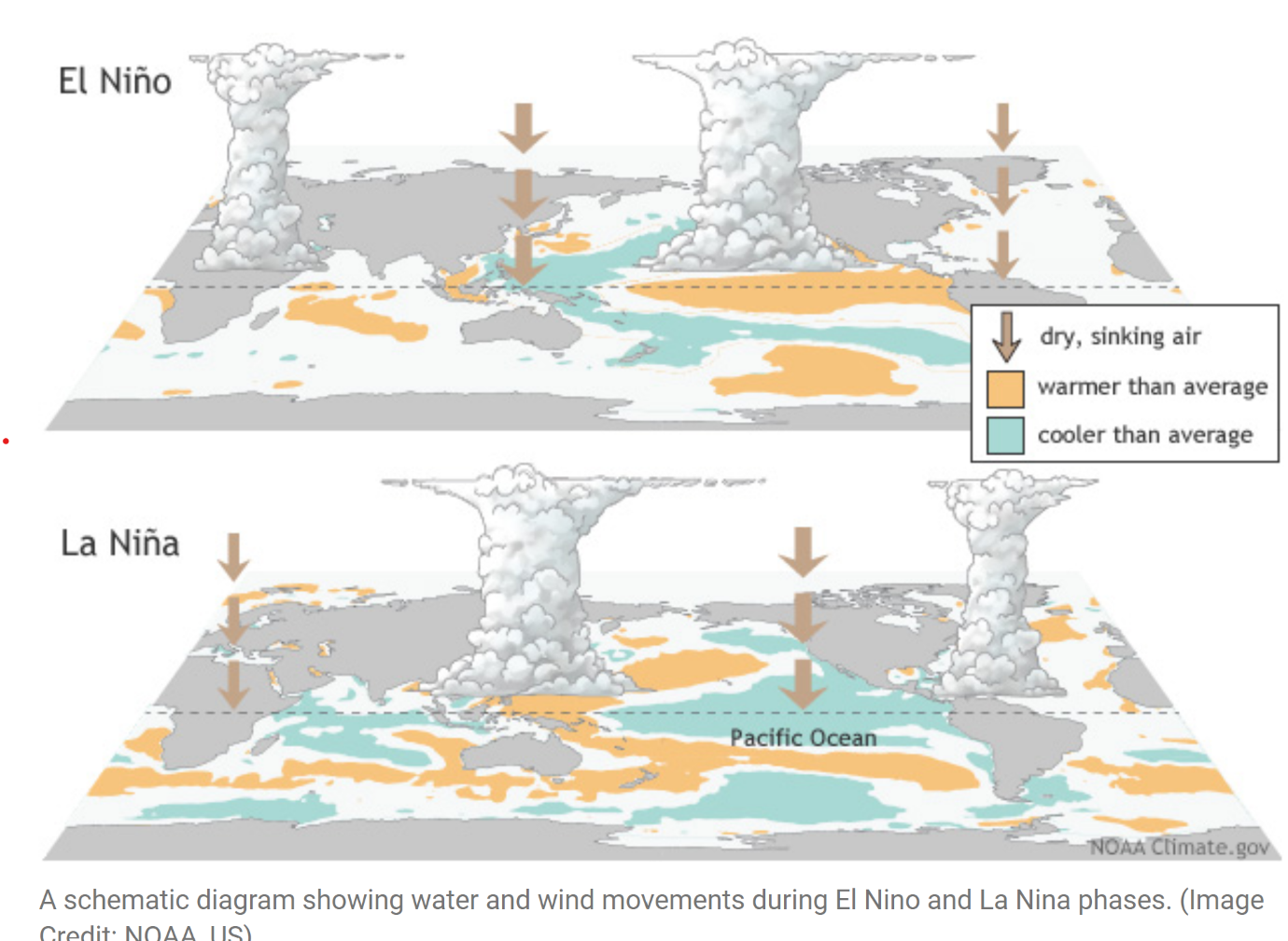
- 07 Sep 2024
- Current Conditions:
- The India Meteorological Department (IMD) reported neutral Indian Ocean Dipole (IOD) conditions.
- La Niña is expected to develop towards the end of the monsoon season, around the end of this month.
- Forecasting Challenges:
- Major global agencies have struggled with accurate forecasts for La Niña’s onset this year.
- Initial predictions suggested La Niña would start around July, but it has been delayed.
- Understanding La Niña:
- La Niña, meaning "The Little Girl" in Spanish, is a phase of the El Niño Southern Oscillation (ENSO).
- ENSO influences global climate through changes in tropical Pacific Ocean sea surface temperatures.
- ENSO phases:
- El Niño (warm phase)
- La Niña (cool phase)
- Neutral
- ENSO Phases Explained:
- Neutral Phase: Eastern Pacific is cooler; trade winds drive warm water westward, causing upwelling of cooler waters.
- El Niño Phase: Weakened trade winds result in warmer eastern Pacific waters.
- La Niña Phase: Strengthened trade winds push more warm water to the western Pacific, cooling the eastern Pacific.
- Impact on India:
- El Niño typically reduces monsoon rainfall; La Niña generally enhances it.
- The previous El Niño occurred from June 2023 to May 2024.
- La Niña episodes can influence severe weather patterns and are linked to higher temperatures, heavy precipitation, and droughts.
- Weather Model Predictions:
- A strong El Niño ended in June, transitioning ENSO to neutral.
- Global models initially forecasted La Niña for July but revised this to August-October.
- IMD’s forecast since April predicted La Niña in the latter half of the monsoon season, aiming for enhanced rainfall in August and September.
- Reasons for Delayed Onset:
- The expected La Niña might be weak, complicating predictions.
- Other atmospheric factors, including the Madden-Julian Oscillation, impact weather models.
- Current and Future Impacts:
- La Niña's first signs are expected by late September or early October.
- It is projected to peak in November and continue through the northern hemisphere winter.
- Monsoon Impact: La Niña’s delayed onset means it won’t significantly affect the current southwest monsoon, though India saw a 16% surplus in August rainfall and a forecast of 109% “above normal” rain for September.
- Potential Effects:
- Northeast Monsoon: La Niña could influence the northeast (winter) monsoon (October-December), impacting Tamil Nadu, coastal Andhra Pradesh, Rayalaseema, south interior Karnataka, and Kerala. While La Niña typically doesn’t favor northeast monsoon rainfall, exceptions have occurred.
- Cyclone Activity: La Niña years often see increased cyclone activity in the north Indian Ocean, with higher intensity and longer-lasting storms.
- Winter Weather: Historically, La Niña years lead to harsher and colder winters, suggesting a potentially severe winter ahead.
India-Maldives Relations Amidst Chinese Influence (Indian Express)

- 14 Oct 2023
Why is it in the News?
Following the recent presidential elections in Maldives, there are concerns about the potential impact on India-Maldives relations due to the 'India-Out' campaign led by President-elect Mohamed Muizzu.
Context:
- The recent election in Maldives resulted in the victory of a candidate perceived as Pro-China for the presidential role, sparking apprehensions for India.
- Maldives had a historical shift from an Executive Presidency system dating back to 1968 to a multi-party democracy in 2008.
- The absence of a re-elected incumbent president since 2008 is causing concern for India on this occasion.
Geographical Bonds Between India and Maldives:
- The Maldives is an archipelago spread across 90,000 square kilometres, predominantly comprising 99.6% of the ocean, leaving the remaining land scattered among over 1,200 islands.
- A concerning forecast by experts suggests that by 2050, 80% of the Maldives may face submersion due to the effects of 'Global Boiling.'
- In this geographical tapestry, India emerges as the closest neighbour, positioned just 70 nautical miles away.
- In times of crisis, it is India alone that stands as Maldives' immediate and unwavering ally.
- The profound words of Ibn Khaldun, the Tunisian philosopher, find resonance in the destiny woven by geography between these two nations.
- As he asserted, geography plays a pivotal role, and in the case of India and the Maldives, it s
How Has India Assisted the Maldives in the Past?:
- Essential Support and Communication Dependence: Historically, Maldives has leaned on India for essentials and communication, with India standing as a consistent and indispensable factor in the island nation's development.
- Even during the British protectorate years (1887-1965), Maldives relied on India for essentials and as a gateway to the outside world.
- State Bank of India's Role in Tourist Economy: India played a pivotal role in shaping Maldives' tourist economy, with the State Bank of India serving as a major financier in building the foundation of the country's tourism sector.
- This enduring support positions the State Bank of India as the largest bank in the Maldives to this day.
- Non-Interference in Internal Developments: Crucially, India has refrained from interfering in Maldives' internal affairs, offering support during critical moments such as the attempted coup in 1988 and subsequent assistance in various forms over the decades.
- The profound dependence of Maldives on India, coupled with India's unconditional support, has played a pivotal role in the island nation's emergence as the highest per capita country in South Asia.
- India's Prompt Response in Crises: During three major crises in 1988 (coup), 2004 (tsunami), and 2014 (water shortage), India emerged as the first responder, exemplifying its commitment to Maldives' well-being.
- Critical Role of Indian Professionals: In education and health, Indian teachers and doctors continue to play crucial roles, extending their influence even to remote inhabited islands.
- Strategic Defense Cooperation: The strategic defence cooperation between India and Maldives goes beyond material assistance, focusing on capacity building through joint exercises like Ekuverin and Ekatha, as well as collaboration in surveillance assets, training 1,400 MNDF trainers in recent years, and disaster management efforts.
What is the Current Situation of India-Maldives Bilateral Relations?
- India stands as the predominant partner in various sectors, be it trade or tourism.
- Demonstrating commitment to elevating Maldives' infrastructure, India is actively engaged in projects such as enhancing connectivity in Greater Male.
- India plays a vital role in supplying a diverse range of essential commodities in bulk, including rice, wheat flour, sugar, potatoes, onions, eggs, vegetables, and even special dispensations like river sand and construction materials.
India's Strategic Interests in Maldives:
- Strategic Significance: Maldives holds paramount importance for India as a primary line of defense against various threats, including terrorism, piracy, drug trafficking, narcotics, and maritime crimes.
- Geographically, Maldives is strategically positioned merely 70 nautical miles from Minicoy and 300 nautical miles from India's West coast.
- It serves as a pivotal point within the commercial sea lanes traversing the Indian Ocean.
- Geo-Political Alignment: India's interests in Maldives align on various fronts, encompassing:
- Securing sea lanes of communication.
- Combating piracy and sea-based terrorism.
- Transforming the Indian Ocean into a conflict-free zone, restoring its status as a peaceful maritime region.
- Exploring the potential of the blue economy and enhancing trade relations.
- Internal Security Concerns: Maldives' proximity and shared maritime borders have direct implications for India's internal security.
- The upsurge in Maldivians joining terrorist groups, such as the Islamic State (IS), poses a significant challenge.
- Political instability and socio-economic uncertainties contribute to the growth of Islamist radicalism, raising concerns about the potential use of remote Maldivian islands as launch pads for terror attacks against India and its interests.
What are the Challenges to India-Maldives Bilateral Relations?
- Rising Islamic Radicalization: The Maldives has witnessed an alarming increase in per capita numbers of individuals joining foreign terrorist groups in Syria and Iraq.
- A 2020 report by the European Foundation for South Asian Studies highlights the challenge of growing Islamic radicalization among the Maldivian population.
- India Out Campaign: The India Out campaign, supported by Maldives' opposition leader Abdulla Yameen and the newly elected president, projects a sceptical view of India's investments and defence partnerships.
- Allegations include concerns about compromising the sovereignty of the island nation by allowing Indian military presence, fostering a negative sentiment towards India's role as a net-security provider.
- The China Factor: China's engagement in the region is perceived as self-serving, characterized by debt financing leading to potential debt traps and China's expanding influence.
- Concerns arise over China's interference in Maldives' internal politics and support for conservative elements, posing a threat to the development of a vibrant democracy.
- There are apprehensions that elements aligning with China may perpetuate a legacy of controlled regimes from the Gayoom era, potentially compromising the nation's long-term interests.
Way Ahead for India-Maldives Relations: Detrimental Effects of Anti-India Campaigns
- India remains steadfast in its commitments to the Maldives, consistently investing in efforts to strengthen bilateral relations.
- Any hasty attempts to unravel this carefully nurtured partnership are poised to inflict more harm on the Maldives than on India itself.
- A telling example is the 2012 'GMR out' campaign, which cost Maldives a substantial $270 million payout to GMR.
- The Yameen era, marked by a pro-China policy, plunged Maldives into a debt crisis, underscoring the potential pitfalls of such geopolitical shifts.
Conclusion
Throughout the decades, India has been a reliable source of security assistance for Maldives, extending a hand of friendship and trust. It is anticipated that the newly elected President Muizzu will likely refrain from taking drastic measures that could alter the fabric of relations with India. While elections are often driven by emotions and promises, the pragmatic realities of governance may lead him to recognize the potential repercussions of undermining the longstanding ties with India.
